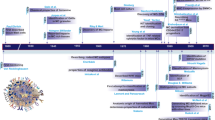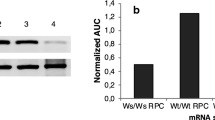Abstract
Objective and design
To determine if mast cells synthesize the inflammatory peptide, neurotensin (NT), secrete immunoreactive and bioactive NT, and express the NT receptor NTS1.
Materials
HMC-1 cells, pleural mast cells from Sprague–Dawley rats, LAD2 mast cells, and human cord blood mast cells were used.
Treatment
HMC-1 cells were stimulated with NT, C48/80, mastoparan, or PGE2. For changes in cutaneous vascular permeability, anesthetized rats were injected intravenously with Evans Blue dye and intradermally with saline, NT, histamine, diphenhydramine, and C48/80.
Methods
RT-PCR was used to identify RNA transcripts. Histamine was measured by fluorometric assay. In vivo cutaneous vascular permeability assays, radio-immunoassays for NT, Western blotting for the NT precursor protein and NTS1 protein from HMC-1 cells and tissues from rats were used. Immunohistochemistry was used to identify NT precursor-like proteins in HMC-1 mast cells.
Results
HMC-1 cells express mRNAs for NT precursor, PC5A processing enzyme and NTS1 receptor. Human cord blood mast cells and LAD2 mast cells express mRNA transcripts for NT precursor and NTS1. Western blotting showed NT precursor and NTS1 receptor in HMC1. Rat tissues with high numbers of mast cells contained NT precursor proteins. NT-like peptides from HMC-1 displayed NT-like bioactivity.
Conclusions
HMC-1 mast cells synthesize and secrete immunoreactive and bioactive NT-like peptide(s) and express the NT receptor, suggesting that NT from mast cells might serve autocrine and paracrine roles.








Similar content being viewed by others
References
Galli SJ, Nakae S, Tsai M. Mast cells in the development of adaptive immune responses. Nat Immunol. 2005;6:135–42.
Miller LA, Cochrane DE, Carraway RE, Feldberg RS. Blockade of mast cell histamine secretion in response to neurotensin by SR 48692, a nonpeptide antagonist of the neurotensin brain receptor. Br J Pharmacol. 1995;114:1466–70.
Theoharides TC, Cochrane DE. Critical role of mast cells in inflammatory diseases and the effect of acute stress. J Neuroimmunol. 2004;146:1–12.
Galli SJ, Tsai M. Mast cells: versatile regulators of inflammation, tissue remodeling, host defense and homeostasis. J Dermatol Sci. 2008;49:7–19.
De Winter BY, De Man JG. Interplay between inflammation, immune system and neuronal pathways: effect on gastrointestinal motility. World J Gastroenterol. 2010;16:5523–35.
Bischoff SC. Physiological and pathophysiological functions of intestinal mast cells. Semin Immunopathol. 2009;31:185–205.
Gui X, Carraway RE. Involvement of mast cells in basal and neurotensin-induced intestinal absorption of taurocholate in rats. Am J Physiol Gastrointest Liver Physiol. 2004;287:G408–16.
Galinsky DS, Nechushtan H. Mast cells and cancer–no longer just basic science. Crit Rev Oncol Hematol. 2008;68:115–30.
Maltby S, Khazaie K, McNagny KM. Mast cells in tumor growth: angiogenesis, tissue remodelling and immune-modulation. Biochim Biophys Acta. 2009;1796:19–26.
Coussens LM, Werb Z. Inflammation and cancer. Nature. 2002;420:860–7.
Nechushtan H. The complexity of the complicity of mast cells in cancer. Int J Biochem Cell Biol. 2010;42:551–4.
Melillo RM, Guarino V, Avilla E, Galdiero MR, Liotti F, Prevete N, et al. Mast cells have a protumorigenic role in human thyroid cancer. Oncogene. 2010;29:6203–15.
Balkwill F. Cancer and the chemokine network. Nat Rev Cancer. 2004;4:540–50.
Mantovani A, Allavena P, Sica A, Balkwill F. Cancer-related inflammation. Nature. 2008;454:436–44.
Carraway R, Leeman SE. Characterization of radioimmunoassayable neurotensin in the rat: Its differential distribution in the central nervous system, small intestine, and stomach. J Biol Chem. 1976;251:7045–52.
Reinecke M. Neurotensin: immunohistochemical localization in central and peripheral nervous system and in endocrine cells and its functional role as neurotransmitter and endocrine hormone. Prog Histochem Cytochem. 1985;16:1–172.
Carraway RE. Neurotensin. In: Becker KL, editor. Principles and practice of endocrinology and medicine. Philadelphia: J. P. Lippencott; 1995. p. 1424–30.
Zhao D, Pothoulakis C. Effects of NT on gastrointestinal motility and secretion, and role in intestinal inflammation. Peptides. 2006;27:2434–44.
Evers BM. Neurotensin and growth of normal and neoplastic tissues. Peptides. 2006;27:2424–33.
Carraway RE, Plona AM. Involvement of neurotensin in cancer growth: evidence, mechanisms and development of diagnostic tools. Peptides. 2006;27:2445–60.
Rosell S. The role of neurotensin in the uptake and distribution of fat. Ann NY Acad Sci. 1982;400:183–97.
Carraway R, Leeman SE. The isolation of a new hypotensive peptide, neurotensin, from bovine hypothalami. J Biol Chem. 1973;248:6854–61.
Carraway RE, Cochrane DE, Salmonsen R, Muraki K, Boucher W. Neurotensin elevates hematocrit and plasma levels of the leukotrienes, LTB4, LTC4, LTD4 and LTE4, in anesthetized rats. Peptides. 1991;12:1105–11.
Carraway R, Cochrane DE, Lansman JB, Leeman SE, Paterson BM, Welch HJ. Neurotensin stimulates exocytotic histamine secretion from rat mast cells and elevates plasma histamine levels. J Physiol. 1982;323:403–14.
Cochrane DE, Boucher W, Bibb P. Neurotensin stimulates histamine release in in vivo skin ‘blisters’ in rats: an effect inhibited by cromolyn or somatostatin. Int Arch Allergy Appl Immunol. 1986;80:225–30.
Barrocas AM, Cochrane DE, Carraway RE, Feldberg RS. Neurotensin stimulation of mast cell secretion is receptor-mediated, pertussis-toxin sensitive and requires activation of phospholipase C. Immunopharmacology. 1999;41:131–7.
Feldberg RS, Cochrane DE, Carraway RE, Brown E, Sawyer R, Hartunian M, et al. Evidence for a neurotensin receptor in rat serosal mast cells. Inflamm Res. 1998;47:245–50.
Bean AJ, Dagerlind A, Hokfelt T, Dobner PR. Cloning of human neurotensin/neuromedin N genomic sequences and expression in the ventral mesencephalon of schizophrenics and age/sex matched controls. Neuroscience. 1992;50:259–68.
Dobner PR, Barber DL, Villa-Komaroff L, McKiernan C. Cloning and sequence analysis of cDNA for the canine neurotensin/neuromedin N precursor. Proc Natl Acad Sci U S A. 1987;84:3516–20.
Kitabgi P. Differential processing of pro-neurotensin/neuromedin N and relationship to pro-hormone convertases. Peptides. 2006;27:2508–14.
Villeneuve P, Lafortune L, Seidah NG, Kitabgi P, Beaudet A. Immunohistochemical evidence for the involvement of protein convertases 5A and 2 in the processing of pro-neurotensin in rat brain. J Comp Neurol. 2000;424:461–75.
Cabot PJ, Carter L, Gaiddon C, Zhang Q, Schafer M, Loeffler JP, et al. Immune cell-derived beta-endorphin: production, release, and control of inflammatory pain in rats. J Clin Invest. 1997;100:142–8.
Hara M, Ono K, Wada H, Sasayama S, Matsumori A. Preformed angiotensin II is present in human mast cells. Cardiovasc Drugs Ther. 2004;18:415–20.
Kempuraj D, Papadopoulou NG, Lytinas M, Huang M, Kandere-Grzybowska K, Madhappan B, et al. Corticotropin-releasing hormone and its structurally related urocortin are synthesized and secreted by human mast cells. Endocrinology. 2004;145:43–8.
Pascual DW, Bost KL. Substance P production by P388D1 macrophages: a possible autocrine function for this neuropeptide. Immunology. 1990;71:52–6.
Butterfield JH, Weiler D, Dewald G, Gleich GJ. Establishment of an immature mast cell line from a patient with mast cell leukemia. Leuk Res. 1988;12:345–55.
Scarpa RC, Carraway RE, Cochrane DE. Insulin-like growth factor (IGF) induced proliferation of human lung fibroblasts is enhanced by neurotensin. Peptides. 2005;26:2201–10.
Carraway RE, Mitra SP, Evers BM, Townsend CM Jr. BON cells display the intestinal pattern of neurotensin/neuromedin N precursor processing. Regul Pept. 1994;53:17–29.
Carraway RE, Mitra SP, Joyce TJ. Tissue-specific processing of neurotensin/neuromedin-N precursor in cat. Regul Pept. 1993;43:97–106.
Carraway RE, Mitra SP, Paradise C. Characterization of large neuromedin-N using antisera towards regions of the neurotensin/neuromedin-N precursor. Peptides. 1991;12:601–7.
Carraway RE, Mitra SP, Salmonsen R. Isolation and quantitation of several new peptides from the canine neurotensin/neuromedin N precursor. Peptides. 1992;13:1039–47.
Bibb PC, Cochrane DE, Morel-Laurens N. Loss of quin 2 accompanies degranulation of mast cells. FEBS Lett. 1986;209:169–74.
Hassan S, Dobner PR, Carraway RE. Involvement of MAP-kinase, PI3-kinase and EGF-receptor in the stimulatory effect of Neurotensin on DNA synthesis in PC3 cells. Regul Pept. 2004;120:155–66.
Barbero P, Rovere C, De Bie I, Seidah N, Beaudet A, Kitabgi P. PC5-A-mediated processing of pro-neurotensin in early compartments of the regulated secretory pathway of PC5-transfected PC12 cells. J Biol Chem. 1998;273:25339–46.
Cochrane DE, Douglas WW. Calcium-induced extrusion of secretory granules (exocytosis) in mast cells exposed to 48–80 or the ionophores A-23187 and X-537A. Proc Natl Acad Sci U S A. 1974;71:408–12.
Kuchtey J, Fewtrell C. Protein kinase C activator PMA reduces the Ca(2 +) response to antigen stimulation of adherent RBL-2H3 mucosal mast cells by inhibiting depletion of intracellular Ca(2 +) stores. J Cell Physiol. 1999;181:113–23.
Feng C, Beller EM, Bagga S, Boyce JA. Human mast cells express multiple EP receptors for prostaglandin E2 that differentially modulate activation responses. Blood. 2006;107:3243–50.
Abdel-Majid RM, Marshall JS. Prostaglandin E2 induces degranulation-independent production of vascular endothelial growth factor by human mast cells. J Immunol. 2004;172:1227–36.
Nakayama T, Mutsuga N, Yao L, Tosato G. Prostaglandin E2 promotes degranulation-independent release of MCP-1 from mast cells. J Leukoc Biol. 2006;79:95–104.
Gurish MF, Austen KF. The diverse roles of mast cells. J Exp Med. 2001;194:F1–5.
Vita N, Laurent P, Lefort S, Chalon P, Dumont X, Kaghad M, et al. Cloning and expression of a complementary DNA encoding a high affinity human neurotensin receptor. FEBS Lett. 1993;317:139–42.
Kitabgi P, Checler F, Mazella J, Vincent JP. Pharmacology and biochemistry of neurotensin receptors. Rev Clin Basic Pharm. 1985;5:397–486.
Moody TW, Carney DN, Korman LY, Gazdar AF, Minna JD. Neurotensin is produced by and secreted from classic small cell lung cancer cells. Life Sci. 1985;36:1727–32.
Nilsson G, Blom T, Kusche-Gullberg M, Kjellen L, Butterfield JH, Sundstrom C, et al. Phenotypic characterization of the human mast-cell line HMC-1. Scand J Immunol. 1994;39:489–98.
Gully D, Canton M, Boigegrain R, Jeanjean F, Molimard JC, Poncelet M, et al. Biochemical and pharmacological profile of a potent and selective nonpeptide antagonist of the neurotensin receptor. Proc Natl Acad Sci USA. 1993;90:65–9.
Rosengard BR, Mahalik C, Cochrane DE. Mast cell secretion: differences between immunologic and non-immunologic stimulation. Agents Actions. 1986;19:133–40.
Acknowledgments
We thank students Alyssa Lillo, Katherine Moon, David Buzanoski and Richard Scarpa for technical help, and Liz Palmer for secretarial help. We thank Sanofi Recherche for the gift of SR48692. Supported by a Tufts Faculty Research Award to D.E.C., by the Department of Biology Carpenter Fellowship program to S.R., by the Arts and Sciences Dean’s Office, by the Tufts University Summer Scholar’s Program and N.I.H. grant # AR47652-06 to Dr TC Theohardides, Department of Pharmacology, Tufts University Medical School (D.E.C., co-investigator).
Author information
Authors and Affiliations
Corresponding author
Additional information
Responsible Editor: Liwu Li.
Kimberly Harrington, Melissa Laudano and Stephen Rawlings were former undergraduate students.
Rights and permissions
About this article
Cite this article
Cochrane, D.E., Carraway, R.E., Harrington, K. et al. HMC-1 human mast cells synthesize neurotensin (NT) precursor, secrete bioactive NT-like peptide(s) and express NT receptor NTS1. Inflamm. Res. 60, 1139–1151 (2011). https://doi.org/10.1007/s00011-011-0378-6
Received:
Revised:
Accepted:
Published:
Issue Date:
DOI: https://doi.org/10.1007/s00011-011-0378-6




